
A check valve may seem like a very small unimportant accessory to add to a sump pump; but it is more important than you think.
There are at least two reasons why it is important to add a check valve to the discharge pipe of a sump pump.
To understand why it is necessary to add a check valve to a sump pump, it is important to understand what they do for a sump pump, how they work, where they should be installed for effectiveness, how long they last, how to handle the noise they cause when in use, and how to identify their failure and how to fix it.
A check valve eliminates the need to re pump the same water over again.

A check valve acts as a gate preventing water from running beyond its gate back into the sump pit and causing the pump to run again. This eliminates unnecessary wear and tear on the pump motor.
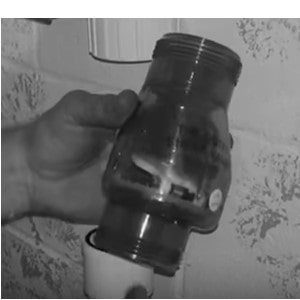
The following short video (just a little over one minute) by AMRE Supply shows so well how a check valve works with a sump pump. Understanding gained from the video aids in seeing why it is necessary to install a check valve for a sump pump.
To be most effective, the best place to install a check valve is between 8 inches above the pump discharge port and no higher than 12 inches above the top of the basin (basement floor).
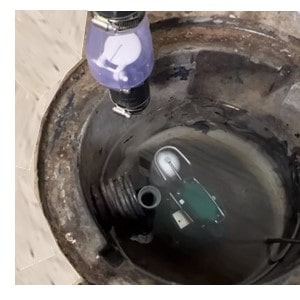
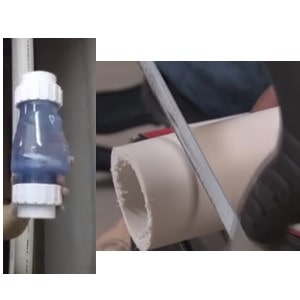
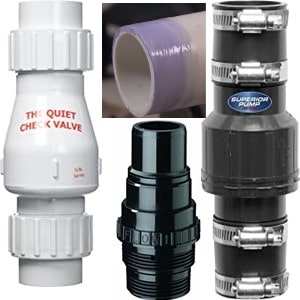
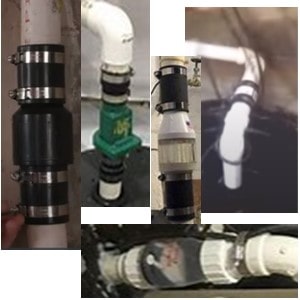
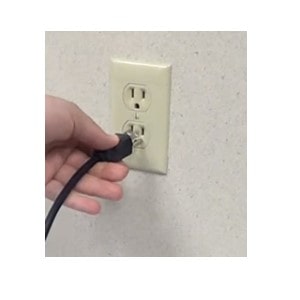
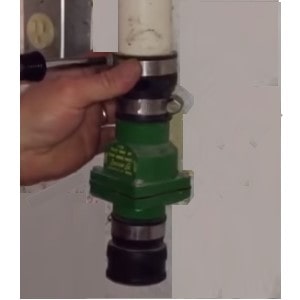
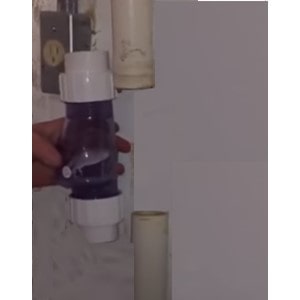


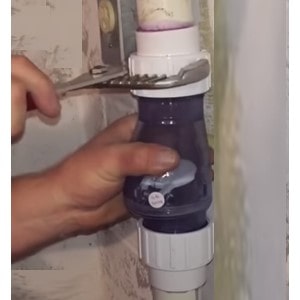
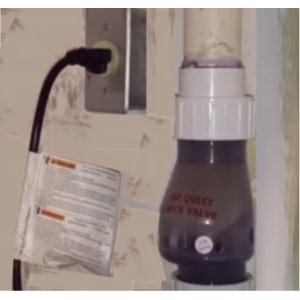

No leaks and the sump pump runs properly? The new check valve installation is completed and successful!
No, a check valve will not cause the sump pump to make more noise than it did before the check valve installation.
The noise after check valve installation is the water hitting the check valve gate (flap) after the pump motor stops and the water abruptly starts flowing backwards down the discharge pipe. This noise can be loud and disruptive.
Yes and No. The water actually causes the noise when it hits the check valve lap or gate. The noise is known as water hammer.
When the motor stops, water in the vertical discharge pipe flows backward and hits the check valve flap or gate preventing it from flowing backward any further. The water flows with great speed and pressure. When it hits the flap or gate, it makes a loud thud.
The loud water hammer noise can be irritating. For this very reason, many types of check valves are available for installation.
The best way to reduce check valve noise is to install a quiet check valve also known as a silent check valve.
Remember, it is the waters reversal of flow that causes the noise. It's the sudden change of the waters flow in direction that causes the noise when it hits the check valve flap or gate.
A quiet check valve uses a spring to control the closing of the gate so the water flow impact is controlled.
The traditional check valve has no spring and the water hits the flap or gate at its own speed.
A silent check valve is a type of check valve built to deafen the sound of water hitting against the flapper or gate of a check valve when the pump shuts off and the water flows backward toward the sump pump.
In an effort to reduce and eliminate the water hammer sound, the Quiet Check Valve was introduced. A Quiet Check Valve has a spring that controls the closing of the check valve gate before the water begins flowing backwards after the pump motor shuts off. This makes the stoppage of water flow backwards less sudden and eliminates hydraulic shock also known as water hammer.
Other models try to eliminate the water hammer sound by using multiple discs and a swing gate without a tension spring. They are not as effective so have been called a Silent Check Valve.
A traditional check valve has a flap or gate that stops the water from flowing below it, but has no spring to make the water backward flow less abrupt. Thus the water slams hard against it and causes a hammer, clunking, or slamming sound.
Listen for the difference here. First you will hear the quiet check valve close, then you will hear the traditional noisy check valve close and lastly you will hear the quiet check valve close again. There is a big difference
All silent check valves are made to perform the same function, but the way they are designed and their effectiveness is not the same.
There are three common types of silent check valves: the Spring-tension Controlled Quiet, the Disc and Spring With No Temsion Control so called the Silent check valve, and the Klunkless with an extra tube to control noise.
The Spring Tension Controlled Loaded Gate Swinging Check Valve is the quietest. The gate closing is controlled by a one-half pound tension spring. It is very hard to hear any water hammer of thumping sound.
Notice the spring inside the check valve and the effort it takes to open the gate. The spring is strong. It can resist up to one-half pounds of pressure.
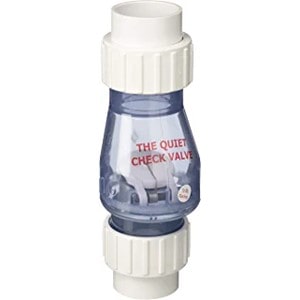
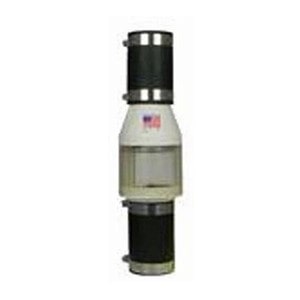
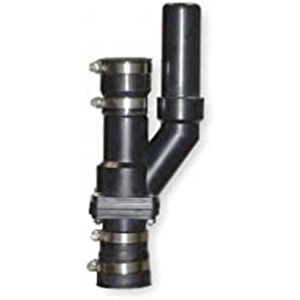
Yes. A silent check valve is worth its cost for at least three reasons.
Matthew Henders shows us how to install a Quiet Check Valve in a sump pump install where no prior check valve was used. Note how he measures and cuts the PVC piping and primes and glues the quiet check valve inline with the discharge pipe. The total installation requires about 30 minutes though the video is much shorter in length.
If the check valve fails, the water being pumped out of the sump pit will flow back into the pit, decreasing the amount of water removed per cycle while also increasing the frequency of cycles, which can cause the pump to fail prematurely.
The good news is that when a check valve fails the sump pump will still keep pumping water though it will be re pumping water that re-enters the pit from the discharge pipe when the pump motor stops.
To prevent check valve failure if a traditional check valve is installed, check it for debris or pebbles caught inside every 6 months. And do replace it every time a new sump pump is installed. A quiet check valve is better built and will last many more years. Ours are 8 years old and still functioning properly.
When the check valve fails you will hear water running below the check valve height into the basin. This is when it is definitely time to replace the existing check valve
There are two main reasons why it is necessary to add a check valve to a sump pump. 1) A check valve extends the life of the sump pump motor because it does not have to re pump water that flows backward into the pit after the pump shuts off 2) A check valve can eliminate the irritating, loud thudding or slamming sound when the pump motor shuts off as the water flows backwards and hits bottom. A traditional check valve will not stop the water hammer noise, but a quiet check valve will.
Check valves are easy to install and definitely worth their cost. The quiet check valve is about twice the price of a traditional check valve, but it will last longer than twice the longevity of a traditional check valve.
We installed a quiet check valve for each of our sump pumps and our sewage pump. They are very durable; they are now over eight years old and they are very quiet. We are glad we made the change because our traditional check valves were failing too quickly and they did not reduce the water hammer noise.
As an Amazon Associate we earn from qualifying purchases.
SHOP QUIET CHECK VALVES WITH SPRING CONTROL (The Quietest Style)
It's the 1/2 pound tension spring that controls the closing of the gate that makes this style of check valve very quiet.
QUIET CHECK VALVES WITH SPRING CONTROL 1.5 inch (1-1/2) Diameter
QUIET CHECK VALVES WITH SPRING CONTROL 2 inch (2.0) Diameter
QUIET CHECK VALVES WITH SPRING CONTROL 2 inch (2.0) Diameter CHECK VALVE PLUS BALL VALVE
The ball valve can be important to stop water from flowing through the discharge pipe from the outside where there could be flooding conditions.
QUIET CHECK VALVES WITH SPRING CONTROL 3 inch (3.0) Diameter
SILENT CHECK VALVES WITH NO SPRING TENSION CONTROL SO ARE NOT QUIET LIKE THE QUIET CHECK VALVE
QUICK SHOP TRADITIONAL CHECK VALVES FOR SUMP PUMPS
These check valves prevent water from returning to the pit so it does not have to be re pumped which will extend the life of the sump pump motor; HOWEVER they do not prevent the water hammer noise.
HELPFUL RESOURCE LINKS TO COMPARE AND SHOP PUMPS
POPULAR BRANDS
BEST SELLERS
DETAILED PUMP REVIEWS
OTHER HELPFUL WEBSITES
OUR MISSION